Research - (2020) Advances in Dental Surgery
Awareness on Rheumatic Heart Disease Among IT-Professionals
Kaushik Vishnu Rajkumar, Vishnu Priya V* and Gayathri R
*Correspondence: Vishnu Priya V, Department of Biochemistry, Saveetha Dental College and Hospital, Saveetha Institute of Medical and Technical Sciences, Saveetha University, Chennai, India, Email:
Abstract
Rheumatic heart disease (RHD) is a serious disease of the heart involving damage to one or more of the four small heart valves. The valve damage remains after an illness called acute rheumatic fever (ARF). During ARF the heart valve tissue, and sometimes other parts of the heart (the heart lining or muscle) can become swollen, and this is called carditis. Following carditis, the heart valves can remain damaged then become scarred, and the result is an interruption to normal blood flow through the damaged valves The heart valve damage may start shortly after untreated or under-treated streptococcal infection such as strep throat or scarlet fever. If left untreated, rheumatic heart disease can lead to heart valve damage, stroke, heart failure, and death. The aim of the study was to create awareness on RHD among IT professionals. An online based questionnaire, which includes 10 questions, was distributed to all the participants. The population consisted of 138 participants of a selected population of IT professionals. A majority of 59.4% were aware of the rheumatic heart diseases. and a minority of 40.6% were unaware. From the obtained results, we may conclude that the majority of IT professionals are aware of RHD. Health education camps, seminars may be conducted to create awareness on the risk factors, pathogenesis, diagnosis, and treatment modality of RHD.
Introduction
Rheumatic heart disease (RHD) is a serious disease of the heart involving damage to one or more of the four small heart valves. The valve damage remains after an illness called acute rheumatic fever (ARF). RHD is an inflammatory disease that can involve the heart, joints, skin, and brain. Signs and symptoms of RHD include fever, multiple painful joints, involuntary muscle movements and occasionally a characteristic non-itchy rash known as erythema marginatum [1]. If left untreated the RHD can cause heart failure, damage the heart, stroke, heart failure, or may even lead to death. Rheumatic Heart Disease is the most acquired heart disease in young people under the age of 25. In most cases it begins in childhood as strep throat, which disease typically develops two to four weeks after a streptococcal throat infection [2]. This can cause serious heart damage that kills or debilitates adolescence, young individuals. It can even cause pregnancy hazardozus. Diagnosis of RF is often based on the presence of signs and symptoms in combination with evidence of a recent streptococcal infection [3]. The signs of rheumatic coronary heart sickness range and damage to the coronary heart often is not with no trouble noticeable. When signs do seem, they may rely upon the extent and vicinity of the heart harm.
Typically, signs of rheumatic fever seem approximately weeks after the onset of an untreated strep throat infection. Apart from the sore throat because of the strep infection, kids have a fever and feel ill. Commonly, the child will have a totally painful, swollen and purple joint, commonly a big joint like a knee, ankle, elbow or shoulder that goes away after a day or two most effective to be replaced by using the same trouble in some other joint. Short lived pores and skin rashes may additionally occur but are not common. Even if the heart is affected, it is also now not severe enough to cause symptoms, although every now and then the kid can be short of breath. Treating people who have strep throat with antibiotics, such as penicillin, decreases the risk of developing rheumatic fever [4]. If the infection is left untreated, rheumatic fever occurs in up to three percent of people [5]. In 2015 it resulted in 319,400 deaths down from 374,000 deaths in 1990 (‘Global, regional, and national age–sex specific all-cause and cause-specific mortality for 240 causes of death, 1990–2013: A systematic analysis for the Global Burden of Disease Study 2013’, 2015). Rheumatic fever occurs in about 325,000 children each year and about 33.4 million people currently have rheumatic heart disease (GBD 2015 Disease and Injury Incidence and Prevalence Collaborators, 2016), with 20% of first-time attacks occurring in adults [6]. In 2015 it resulted in 319,400 deaths down from 374,000 deaths in 1990 (‘Global, regional, and national age–sex specific all-cause and cause-specific mortality for 240 causes of death, 1990–2013: A systematic analysis for the Global Burden of Disease Study 2013’, 2015). Description of the condition are believed to date back to at least the 5th century BCE in the writings of Hippocrates [7]. The aim of the study was to create awareness on RHD among IT professionals.
Materials and Methods
A questionnaire-based survey was conducted based on the awareness on RHD among the IT professionals. The study protocol was approved by the institutional review board, Saveetha Dental College. The sample size of the study was 138 participants. The survey questionnaire consisted of 10 questions and was administered to the participants through survey planet link. The responses were collected, and the obtained data was statistically analyzed.
Results and Discussion
From the survey results collected among 138 IT professionals, the awareness on Rheumatic Heart Disease among IT professionals was determined. 59.4% of the participants were aware of RHD and 40.6% of the participants unaware of RHD (Figure 1). Majority of the population were aware of rheumatic heart disease. 29% were aware of the types of RHD and 71% were not aware of the types of rheumatic heart disease (Figure 2). Majority of the population were not aware of the types of rheumatic heart disease.
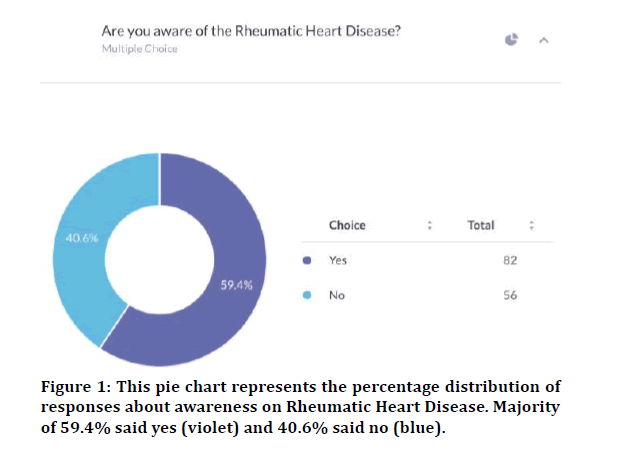
Figure 1: This pie chart represents the percentage distribution of responses about awareness on Rheumatic Heart Disease. Majority of 59.4% said yes (violet) and 40.6% said no (blue).
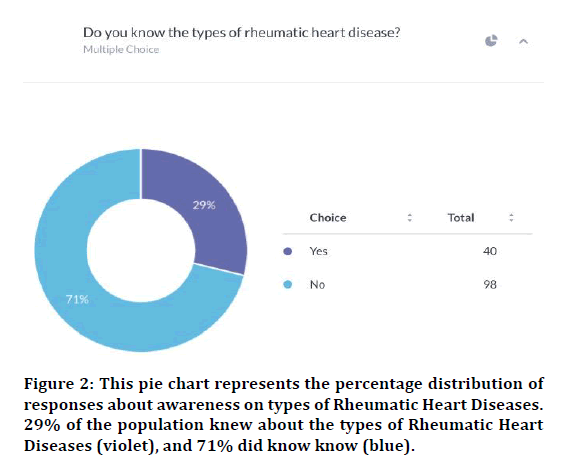
Figure 2: This pie chart represents the percentage distribution of responses about awareness on types of Rheumatic Heart Diseases. 29% of the population knew about the types of Rheumatic Heart Diseases (violet), and 71% did know know (blue).
37% were aware of the various risk factors which causes rheumatic heart disease and a majority of 63% were not aware of the various reasons which cause rheumatic heart disease (Figure 3). 11.7% of the participants had family members who had rheumatic heart disease and 88.3% did not have a family member who had Rheumatic heart disease (Figure 4). 30.9% of the participants were aware that rheumatic heart disease is not curable and 69.1% of the participants did not know that rheumatic heart disease is not curable (Figure 5).
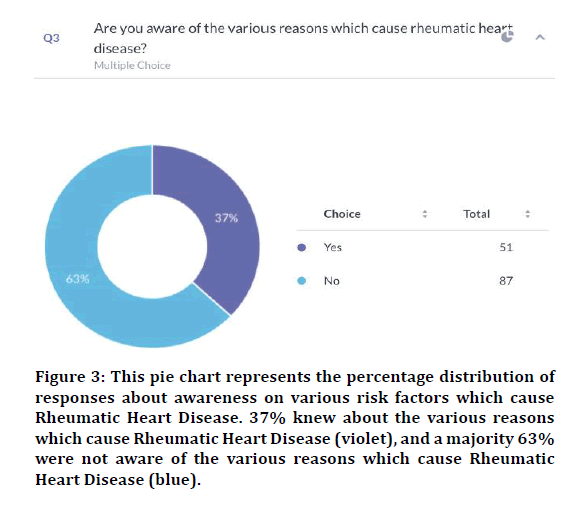
Figure 3: This pie chart represents the percentage distribution of responses about awareness on various risk factors which cause Rheumatic Heart Disease. 37% knew about the various reasons which cause Rheumatic Heart Disease (violet), and a majority 63% were not aware of the various reasons which cause Rheumatic Heart Disease (blue).
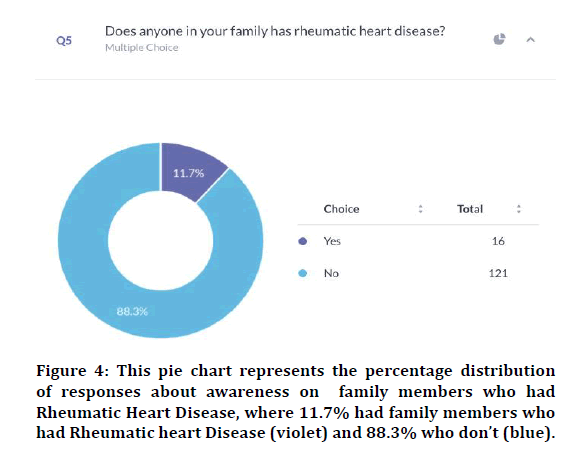
Figure 4: This pie chart represents the percentage distribution of responses about awareness on family members who had Rheumatic Heart Disease, where 11.7% had family members who had Rheumatic heart Disease (violet) and 88.3% who don’t (blue).
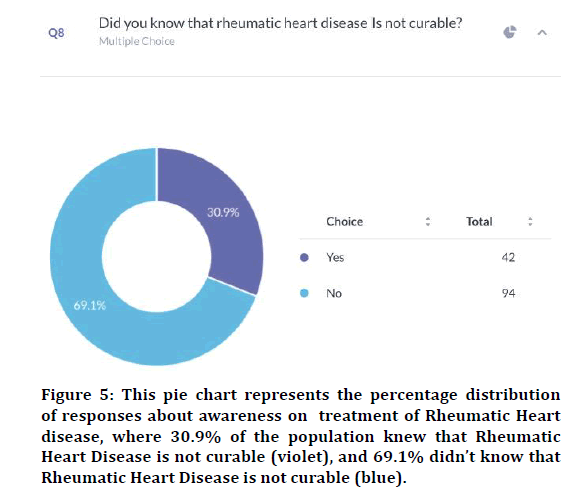
Figure 5: This pie chart represents the percentage distribution of responses about awareness on treatment of Rheumatic Heart disease, where 30.9% of the population knew that Rheumatic Heart Disease is not curable (violet), and 69.1% didn’t know that Rheumatic Heart Disease is not curable (blue).
Rheumatic heart disease and its complications are responsible for preventable morbidity and mortality in the younger age groups in endemic regions. There is a need for better clinical and echocardiography-based prevalence studies from regions where RHD is still endemic [8].
Half of the cases of infective endocarditis and substantial proportion of strokes in Asian countries were attributed to underlying rheumatic heart disease. Primary prevention strategies though ideal are not entirely feasible for large populations such as rural India, but tertiary prevention measures that include both medical and surgical care may be an alternative cost-effective approach for RHD [9].
Conclusion
From the study, we may conclude that most IT professionals are aware of RHD. Health education camps, seminars may be conducted to create awareness on the risk factors, pathogenesis, diagnosis, and treatment modality of RHD. This may help in educating the community about Rheumatic Heart Disease. Strategies for preventing RHD should involve primary prevention and strengthening of secondary prophylaxis through community education and through encouragement of patients, parents and doctors.
References
- Marijon E, Mirabel M, Celermajer DS, et al. Rheumatic heart disease. Lancet 2012; 379:953–964.
- Lee KY, Rhim JW, Kang JH. Kawasaki disease: Laboratory findings and an immunopathogenesis on the premise of a protein homeostasis system. Yonsei Med J 2012; 3:262-275.
- Nune A, Ling S, Gorodkin R, et al. Rheumatologists beware, rheumatic fever remains prevalent: A case of acute rheumatic fever. Rheumatol 2015; 54:i54.
- Spinks A, Glasziou PP, Del Mar CB. (2013) Antibiotics for sore throat. Cochrane Database Systematic Rev 2013; 2013:CD000023.
- Righi C, James J. User-centered design stories: Real-world UCD case studies. Elsevier 2007.
- Kumar V, Abbas A, Aster J. Robbins basic pathology. 10th Edn Elsevier Health Sciences 2017.
- Quinn RW. Did scarlet fever and rheumatic fever exist in Hippocrates’ time?’, Reviews Infectious Disease 1991; 13:1243–1244.
- Carapetis JR. Rheumatic heart disease in Asia. Circulation 2008; 18:2748–2753.
- McDonald M, Brown A, Noonan S, et al. Preventing recurrent rheumatic fever: The role of register based programmes. Heart 2005; 91:1131–1133.
Author Info
Kaushik Vishnu Rajkumar, Vishnu Priya V* and Gayathri R
Department of Biochemistry, Saveetha Dental College and Hospital, Saveetha Institute of Medical and Technical Sciences, Saveetha University, Chennai, IndiaCitation: Kaushik Vishnu Rajkumar, Vishnu Priya V, Gayathri R, Awareness on Rheumatic Heart Disease Among IT-Professionals, J Res Med Dent Sci, 2020, 8 (7): 150-152.
Received: 15-Sep-2020 Accepted: 19-Oct-2020 Published: 26-Oct-2020
